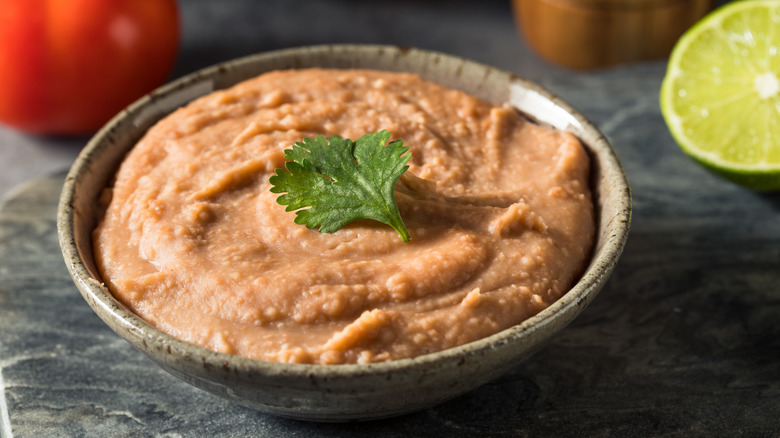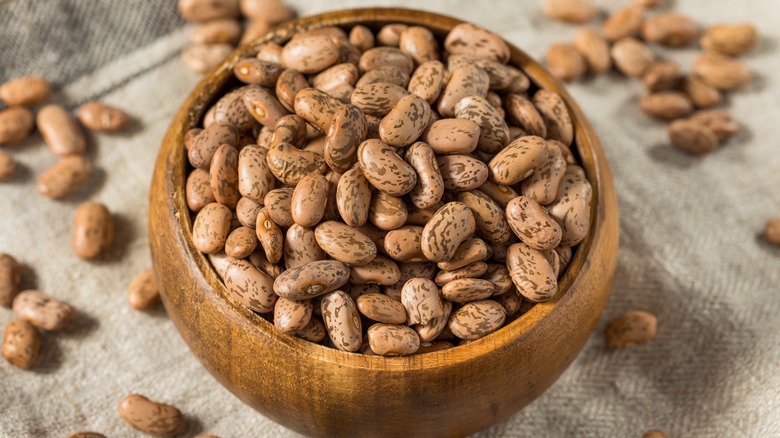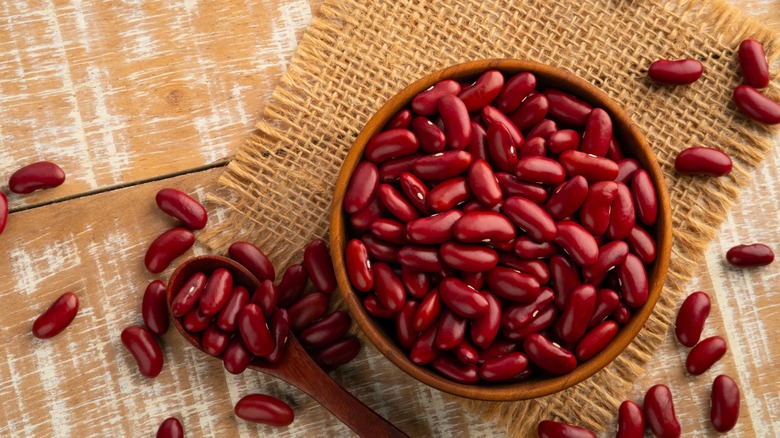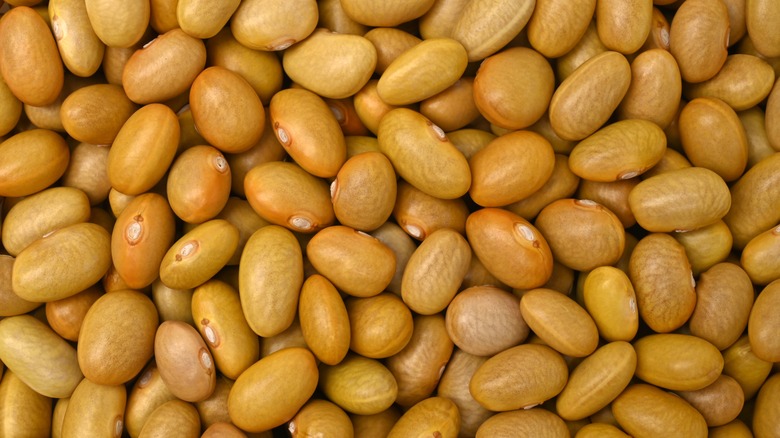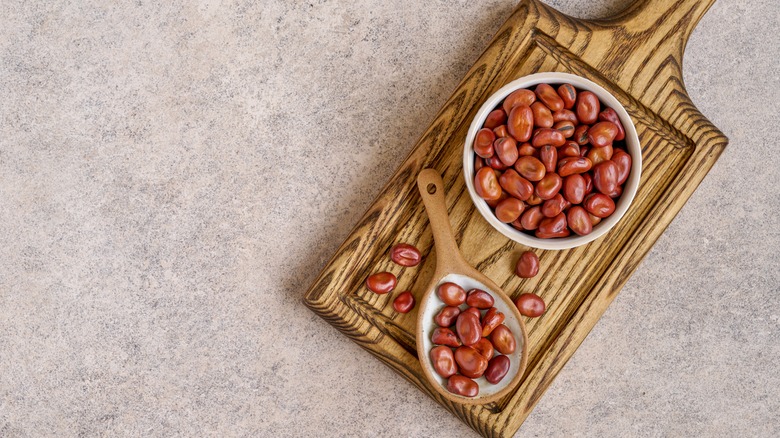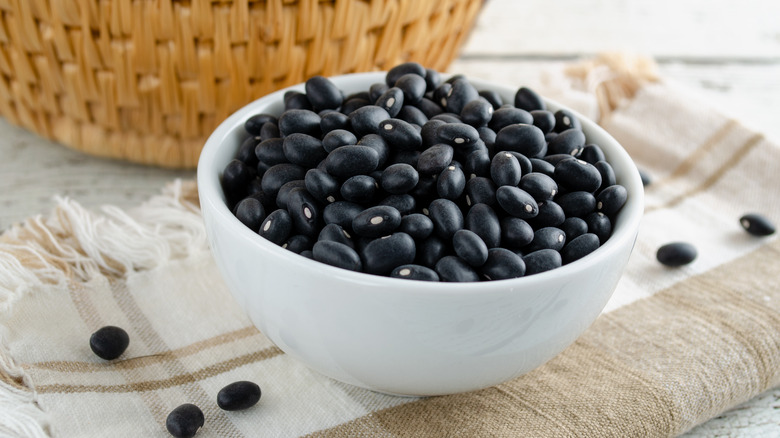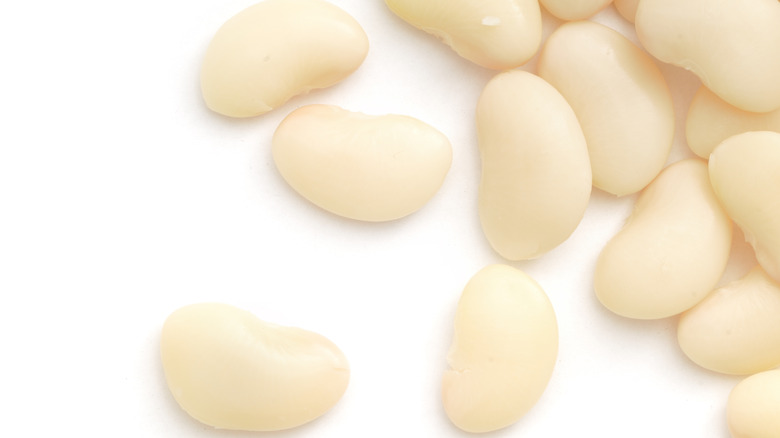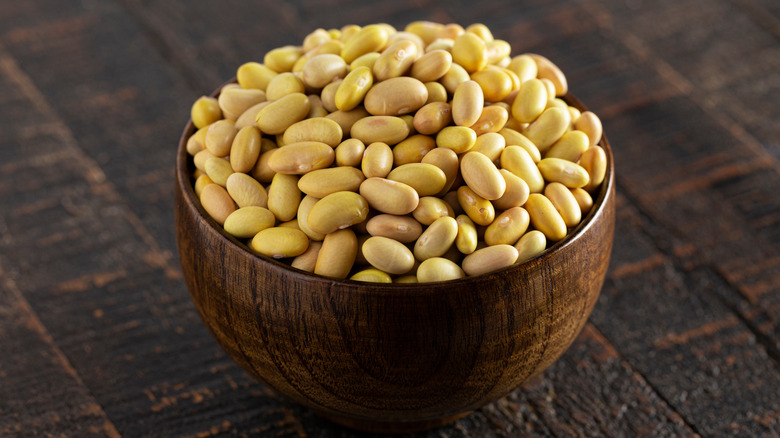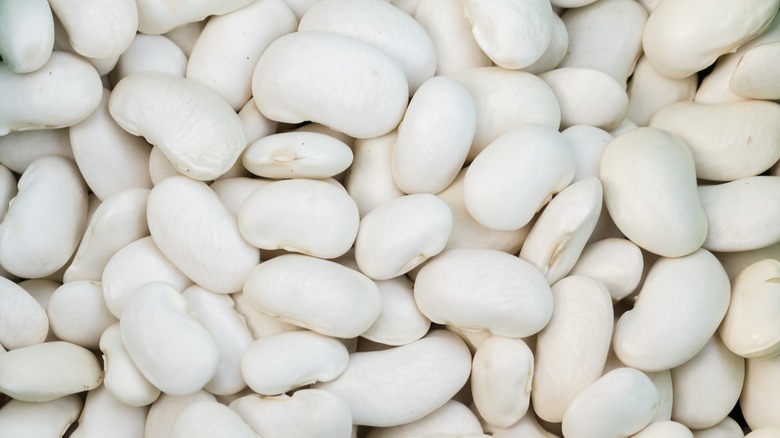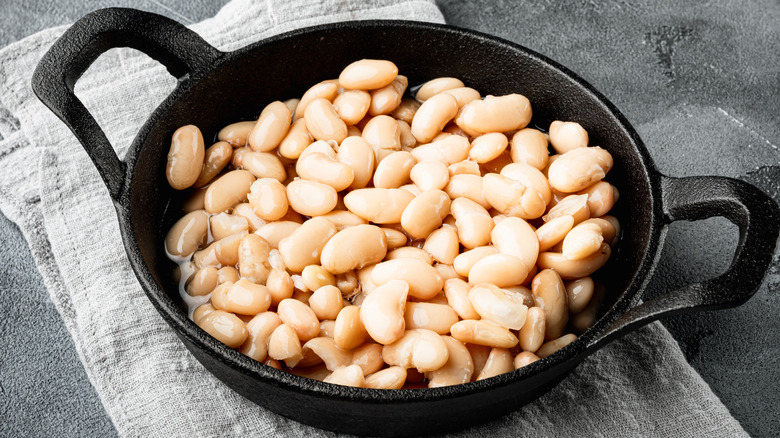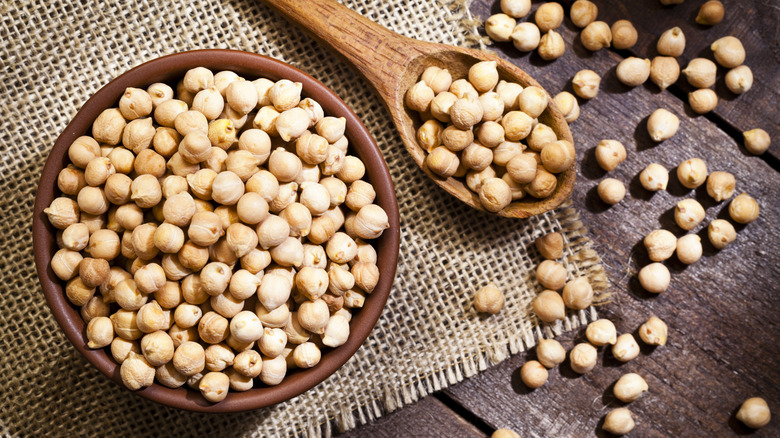Beans You Should And Shouldn't Use When Making Refried Beans
Stuffed into tacos or burritos, used as a dip, eaten as a side — refried beans are versatile and delicious. These tasty, squidgy beans are popular in Latin American and Tex-Mex cuisines, but many fans don't even know what beans they're usually made with. Whether you're looking to forgo store-bought refried beans and make your own for the first time, or you want to try out something different from your usual go-to, you should learn the beans you should and shouldn't use when making refried beans.
I've eaten — and made — a lot of refried beans in my time, but don't just take my word for it. I wanted to learn from chefs, food bloggers, and cookbook authors experienced with Latin American food. So, I interviewed four such experts to get their opinions on the best and worst options for refried beans. Some beans are clearly good or bad choices, while others are more divisive, with both fans and detractors. Ultimately, beans are beans, and any of them will work in a refried beans recipe to some extent or another, but you might not get the texture or flavor that you're expecting.
Learning which beans to use and which to avoid can only improve your refried beans. And, let's not forget that many kitchen rules are made to be broken, so once you know the right way to do things, you can experiment beyond these confines. If it tastes good, it can't be wrong.
Use: Pinto beans
Pinto beans are often used in Mexican and Southwestern cuisine and are the most common choice for refried beans. You'll find them in most classic refried bean recipes. They're medium-sized with a slightly speckled exterior. They have a creamy texture and a mild flavor with a hint of nuttiness, making them an excellent base for this popular dish.
They're the top choice of Mexican-American food blogger and recipe developer Kristyn Merkley, who runs Lil' Luna. "Pinto beans have always been our go-to beans for making refried beans," she says. "Their flavor and creaminess make them the bean of choice for most Mexican recipes."
Yvette Marquez-Sharpnack, cookbook author and food blogger at Muy Bueno, also recommends these beans. "I grew up in El Paso, Texas eating homemade refried beans made with pinto beans," she remarks. "They are usually served as a side dish with a Mexican meal, as a bean dip served with tortilla chips, or slathered on a homemade flour tortilla for the best bean burrito," she adds.
So, if you're looking to make typical refried beans, pintos are what you should start with. While the most authentic recipes start with dried beans, it's totally fine to use canned. And, the great thing about making your own refried beans from scratch is that you can season them according to your tastes, whether you like them simple or with lots of spices.
Don't use: Red kidney beans
Many people mistakenly believe that refried beans are usually made from red kidney beans because of the dish's red-brown color. But, the truth is, kidney beans aren't an ideal choice for refried beans and those in the know usually recommend against using them. They might be a popular choice in some Tex-Mex and Latin American dishes, but don't assume that means they're good for making refried beans.
"Red beans are never used for refried beans in Mexico," says chef Iliana de la Vega, owner of El Naranjo in Austin, Texas. They "have a sweeter flavor that doesn't pair well with traditional refried bean preparations," she adds. "I'm not a fan of the flavor and texture of kidney beans," says cookbook author Yvette Marquez-Sharpnack, so that's another vote against these beans. They aren't as creamy as pintos, so this gives you a less-than-ideal texture. The skins are also thicker, so they don't mash into the mixture as well, which also affects the texture.
But, not everyone is totally against using them. "It's rare to see kidney beans used for refried beans, but they can also be used with good results," says Manny Arce, corporate chef at Poquitos in Seattle. So, if that's all you have on hand or you really love them, it's worth giving them a go. To get the right consistency, you might need to add a bit more liquid than you would with pintos.
Use: Bayo beans
You may not have heard of bayo beans, as they're not nearly as popular in the U.S. as they are in Mexico. However, if you're looking for something different to make your refried beans with, you need to try them. You might need to go to a Mexican grocery or buy them online, but they're totally worth making the effort to seek out.
Chef Iliana de la Vega says bayo beans are among her top choices, noting they "have a deeper brown color than pintos and a delicious deep flavor." If you're looking for a slightly different flavor profile than what you're used to, these beans might be the answer. They have a complex flavor, but it's still neutral enough to work with the aromatics and seasoning that go into refried beans.
The beauty of bayos is that they're smaller than pinto beans, so they take significantly less time to cook. This is a major advantage if you want to cook dried beans from scratch — but just be aware that dried beans can go bad, and this can lead to longer cooking times without them softening. The other thing that makes bayos perfect for refried beans is their texture. They're even creamier than pintos with very thin skin, so if you like your refried beans extra smooth, you need to try these legumes.
Don't use: Fava beans
If you've got some fava beans hanging out in your pantry that you're considering making refried beans from, it's time to reconsider. According to one of our experts, they're not among the best types of beans to use in this dish. "I recommend avoiding beans with a thick skin that do not mash well," says chef Manny Arce, citing fava beans as one such legume.
If you're not familiar with them, here's what you need to know about fava beans. These are large beans that are commonly used in Mediterranean and Middle Eastern cuisine and have been cultivated for food for thousands of years. They come in both fresh green versions, which are sometimes called broad beans, and dried brown-skinned types. The fresh ones are the worst choice for refried beans because the center is firm, more like a pea or an edamame bean. It doesn't have the creamy texture you want for the dish in question.
The brown-skinned type has a creamier center, but the skins are still too firm to mash down properly. So, whatever fava beans you're presented with, they aren't ideal for making refried beans.
Use: Black beans
Outside of pintos, black beans are perhaps the most common option for making refried beans. Although they're small and their skins aren't especially thin, they're creamy and flavorful, making them a great choice. Not to mention that they're highly nutritious, which is one of many reasons why you should eat more black beans.
"I prefer refried black beans over any other because they have a hearty, rich, and earthy flavor," says chef Iliana de la Vega. They're also a favorite of food blogger Kristyn Merkley. "Although they may not be as creamy and buttery as refried [pinto] beans, the flavor of refried black beans is incredible and we often use them for tostadas and as a side dish," she says.
Recipe developer and cookbook author Yvette Marquez-Sharpnack is another fan of refried black beans. She shares how she makes them: "I like to sauté chopped onions, bell peppers, and then mash homemade black beans and serve them drizzled with fresh lime juice." This is a super simple method but a delicious one. Another great thing about black beans is that they're extremely simple to get hold of. You won't need to go to any specialty shops, as you can find them in practically any grocery store.
Don't use: Lima beans
Lima beans are sometimes also known as butter beans or sieva beans. Depending on the type, they can be pale green or white. Baby lima beans are small and tender, while other lima bean varieties can be larger and starchier. Their mild, buttery flavor means they're generally versatile, but they're among the legumes chef Manny Arce says you should never use to make refried beans.
Arce dislikes them because he believes they don't mash properly. This means they won't give you the creamy texture that most people are looking for from refried beans. However, it may be that some lima beans are better than others for this dish. The white types are creamier and, therefore, mash fairly well, while the green types have a firmer center and don't get smooth enough. So, maybe it's less about avoiding lima beans altogether and instead choosing your limas carefully.
While the flavor is a lot subtler than that of more common choices, such as pinto and black beans, the fact that it's mild and unassuming means it doesn't fight against seasonings. Whether you like to add a lot of spices, herbs, and aromatics to your beans or keep them simple, the flavors that you choose to use will shine against the backdrop of limas. We're not going to write them off altogether but proceed with caution.
Use: Mayocoba beans
Unless you're a real bean nerd, you might not have heard of mayocoba beans. Also known as canary beans, Mexican yellow beans, and Peruvian beans, they're extremely common in Mexico and some other parts of Central and South America, but less so in North America. These beans are small with fairly thin skins and a creamy interior, not unlike bayo beans or haricot beans. This collection of attributes makes them a great choice for making refried beans.
When cooked down with liquids, they mash nicely, forming a smooth, creamy paste. They're softer than pinto beans, so it takes less effort to reach that kind of consistency. Usually, you'll find them dried, rather than canned, but since they're small, they have a relatively short cooking time, so you won't have to stoop over a hot stove for hours getting them soft.
Their quick cook time is one of the reasons Manny Arce favors them for making refried beans. He also appreciates that they don't have too strong a flavor on their own. This means they won't overwhelm the other flavors in your recipe, which can be an issue with some types of beans. Another great thing about mayocobas is that they aren't your run-of-the-mill beans. So, if you're someone who likes to be creative and try new things in the kitchen, this could be an opportunity to cook with a type of bean you've never tried before — and that's exciting!
Don't use: Corona beans
Corona beans are large white beans that hail from Italy. They're known for their impressive size, but this largeness also means that they have thick, fairly tough skins. And, this is why chef Manny Arce recommends avoiding them for making refried beans. While they have a creamy texture when cooked, this still can't make up for the skins. The skins don't mash, so you can end up with large pieces in your refried beans.
An additional potential downside to cooking with coronas is that they're big and, therefore, have a long cooking time. It's not a problem if you can find them canned, but they're usually sold dried, which means hours of simmering. Not everyone wants to put that kind of effort into cooking, and that's okay.
That said, if you want to make the most of their soft centers, you could try blending your refried beans. This isn't the traditional way to make the dish, but corona beans just don't do well being mashed. Using a blender could let you make the most of their creaminess if you absolutely want to give them a try. Another potential benefit to corona beans, once you see beneath their tough outer layer, is that they have a mild flavor, so they can easily take on the tastes of the other seasonings that you use. What's more, they add a slight nuttiness, which is tasty and could bring something special to your refried beans.
Use: Cannellini beans
Cannellini beans aren't exactly a traditional choice when it comes to making refried beans, but some people think they're a good choice. They're very soft and creamy and have thin skins, so that lends itself well to the dish. You can easily mash them to get the consistency you expect, whether you like your beans thin or thick. "These beans also have a fairly neutral flavor, which allows them to take on flavors and spices very well," says Manny Arce. However you choose to season your cannellini beans, you know they won't be battling against the other flavors for dominance.
But, Kristyn Merkley of Lil' Luna disagrees. She doesn't think cannellini beans are creamy enough to make refried beans. Plus, chef Iliana de la Vega doesn't think that they — or white beans in general — have the right sort of flavor for making refried beans. "White beans have a lighter, more delicate flavor that tends to be overpowered by the fat used in the dish," she says.
To use or not to use — that is the question when it comes to cannellini beans. They certainly wouldn't be our first choice, but they're not a bad pick if they're what you have to hand. They mash well and don't overwhelm the other flavors in the dish. However, if you want a bean that will hold its own better against the strong flavors, cannellini beans might not be it.
Don't use: Garbanzo beans
Garbanzo bean — or chickpeas — are more commonly used in Middle Eastern and Mediterranean food than in Latin American cuisine. But this isn't the only reason why they're not the best choice for refried beans. "Chickpeas should be avoided because they are more dense and firm, resulting in a less creamy texture, which is not ideal for refried beans," recipe developer Kristyn Merkley says.
Rather than the smooth, creamy refried beans that you're after, you might be left with something much grainier, without that mushy texture you expect. This can be a particular issue if you're using canned chickpeas, as they tend to be firmer than those cooked from scratch. For those of you with a can of chickpeas at the back of the pantry, it might be better to use them for something else. If you're looking for alternative ways to use these beans, there is a wide range of chickpea recipes you could try, from hummus and falafel to curries and salads.
That said, not all of our experts are totally against using garbanzo beans for this dish. Manny Arce notes that chickpeas can be used with some success. "These tend to be a bit starchier than other varieties, so you may need more liquid or fat to thin them out for refried beans," he adds.
